Description and Function of the System Components
Anti-icing vessel
The aim of the anti-icing device and the anti-icing vessel is to provide the compressed air with anti-icing fluid. The anti-icing fluid mixes with any moisture in the compressed air, prevents the fluid mixture from freezing and allows it to be drained off.
Function
When the compressor charges the braking system a partial vacuum is formed in the anti-icing vessel that allows it to draw air through an inlet in the vessel housing.
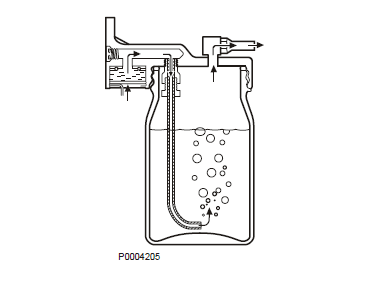
This inlet air is led via a tube down into the anti-icing fluid. When the air rises through the fluid in the form of bubbles it carries with it evaporated fluid to the upper part of the vessel. The air and the evaporated fluid is then drawn through a pipe to the compressor inlet and thus enters the braking system.
Single tower dryer, function
Charging phase
Air is forced from the compressor (1) to the air dryer inlet (2).
From here, the air passes through the drying agent in the vessel (3). The drying agent comprises porous balls called zeolites that have the ability to remove moisture from air. The dried air is then forced through the outlet (4) to the dry tank (5) and then on to the primary tank (6).
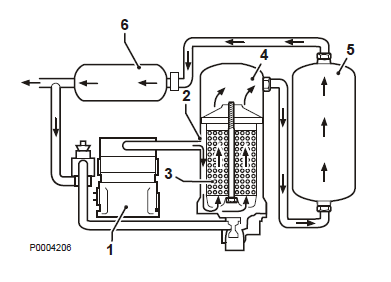
Cycle phase
When the compressed air system has reached full operating pressure, the pressure regulator (7) opens in answer to an air impulse from the drain valve (8) in the air dryer. The dry air from the dry tank (5) then blows back to the air dryer through the drying agent and carries with it any condensate out through the drain valve (8). A check valve (9) prevents air in the primary tank from flowing back to the air dryer when it cycles. There is a heating coil around the drain valve controlled by a thermostat. The heating coil prevents ice from forming in the drain valve.
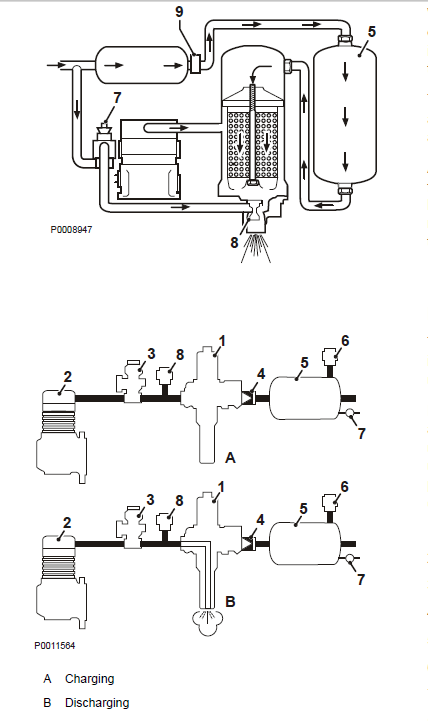
Pressure regulator
There are different types of pressure regulator depending on the type of air drying system and compressor used in the installation. In installations with an anti-icing system that includes an alcohol vessel, or installations where small air volumes are used, we recommended that a pressure regulator
(1) with dump valve be installed. This is done to prevent air from recirculating back to the compressor
(2) and being heated. This shortens compressor life.
1 Pressure regulator
2 Compressor
3 Anti-icing injector
4 Check valve
5 Wet tank
6 Safety valve
7 Drain tap
8 Safety valve
NOTICE! If an air dryer is used in the installation, a dump valve is usually included in the air dryer system.
Pressure regulator
For use together with anti-icing injector:
1 Inlet from compressor
2 Outlet to wet tank
3 Dump outlet
4 Piston
5 Control impulse from wet tank
6 Check valve
7 Dump valve
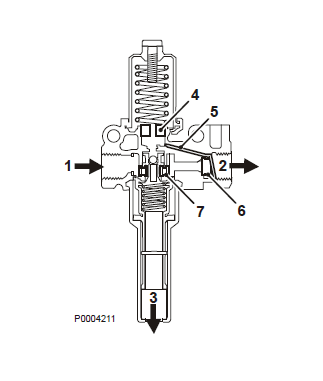
Safety valves
The compressed air system must be equipped with a number of safety valves in order to protect the system against excess pressure (refer to the Design and Function of the Compressed Air System page 120 section in this chapter). Safety valve opening pressures vary depending on the parts they are protecting and the type of compressor the vehicle is equipped with. The objective of the valve (9) is to protect the compressor from excess pressure. Valve 9a is installed on the primary tank.
Safety valve, function
Pressure from the part of the system the valve protects reaches the safety valve via the inlet (1). When pressure exceeds valve opening pressure a passage between the inlet (1) and the outlet (3) is opened by a ball (2) that compresses a spring (4) and allows excess pressure to escape to atmosphere.
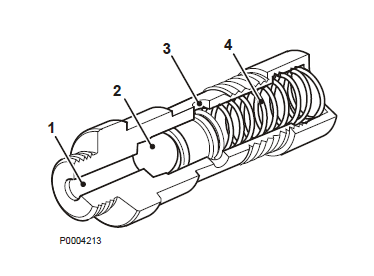
Drain valve for compressed air tank
All compressed air tanks must be fitted with manual drain valves to allow condensate to be drained. The tanks must be drained regularly in order to check air dryer function and to avoid any moisture ingress in the braking system. Condensate must be drained daily on vehicles with anti-icing devices.
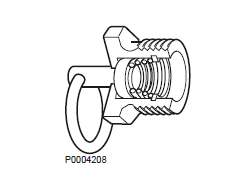
Compressed air tank
Air from the compressor is stored in compressed air tanks and is delivered from the tanks to the various parts of the regulator system. Braking system tanks may be manufactured in aluminum alloy or steel and have a maximum pressure of around 10 bar (145 PSI).
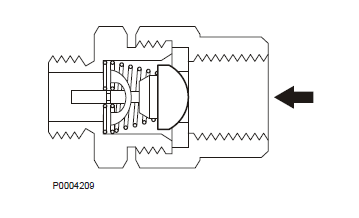
Check valve
The function of the check valve is to ensure flow in one direction. Check valves are used in the delivery system. The check valve (No. 8 on the primary tank, refer to Design and Function of the Compressed Air System page 120 section in this chapter) prevents air from flowing from the primary tank through the drain valve in the air dryer when the compressor is idling.
Cooling Coil and Pipe Dimensions
In order to cool compressed air from the compressor there must be a cooling coil or sufficiently long pipe in the delivery system installed immediately after the compressor air outlet. The cooling coil should be located in a well-ventilated space; pipe length is governed by how well ventilated the space is once the coil is installed. If an inner pipe diameter of 16 mm (0.63") is used in the supply system from the compressor, a 4 m (13.1 ft) long cooling coil will be necessary. If an inner pipe diameter of 22 mm is used, the cooling coil need only be 2.5 m (8.2 ft) long. A cooling coil is used because the dump valve in the pressure regulator or air dryer has a maximum operating temperature limit. Volvo Penta provides pressure regulators to D9 - D16 engines as accessories that have an operating temperature of maximum + 50 °C (100 °F). If the cooling coil is not installed on the engine, a flexible hose must be installed between the compressor and the cooling coil. The flexible hose must be oil resistant and suitable for hydraulic fluid in order to withstand the pressure.
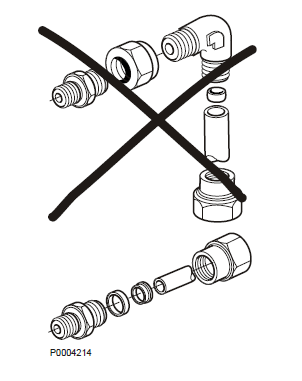
NOTICE! Do not install a 90 degree bend in the compressor outlet, as there is a risk of carbon build-up in the bend.
For More Volvo Engine workshop information, please visit
Volvo Penta Diesel Engine Alignment
Copyright © Guangxi Dingbo Generator Set Manufacturing Co., Ltd. All Rights Reserved | Sitemap
Update cookies preferences